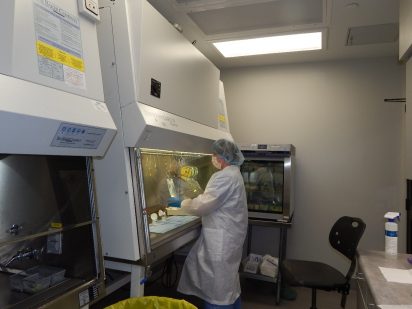Trinity Health staff who have any involvement in handling hazardous pharmaceuticals can feel even more
protected these days.
Trinity Health is proud to be among a small but growing number of health systems to achieve compliance with new U.S. Pharmacopeia (USP) guidelines. The guidelines regulate the handling of hazardous drugs such as chemotherapy agents.
Carolyn Bodell, R.Ph., pharmacy oncology specialist, says the new standards, known as USP 800 guidelines, strengthen previous USP protocols governing the handling of hazardous drugs. What’s new is that health systems now must consider the safety of everyone up and down the supply chain.
“The USP 800 standards are designed to protect anyone who has contact with hazardous medications, from material handlers and environmental employees, to pharmacy staff, nurses, providers, patients, and even visitors to our facilities,” Bodell said.
A hazardous drug is any drug that can cause physical changes to the human body. According to Bodell, they come in three main groups or categories:
Group 1: Antineoplastic drugs a.k.a. cancer chemotherapy drugs
Group 2: Non-antineoplastic drugs that meet one or more of the National Institute for Occupational Safety and Health criteria for a hazardous drug
Group 3: Drugs that primarily pose a reproductive risk to men and women who are actively trying to conceive or pose a risk to women who are pregnant or breastfeeding
Trinity’s CancerCare Pharmacy, located in Health Center – Town & Country, has a staff of six pharmacists and three technicians who compound (mix), process, and deliver hazardous drugs and other medicines for cancer patients, all the while ensuring the “five rights” of medication administration are correct: the right patient, the right drug, the right dose, the right route, and the right time.
Their workspace befits a science fiction movie, with environmentally controlled “clean” rooms maintained under negative pressure so no particles escape, hooded work areas for compounding, buffer rooms, and clinicians decked out in protective gear. Yet these strict standards have now been made even more robust under the new guidelines. During a three-month period or so, the pharmacy was upgraded with additional safeguards.
“We added a negative pressure receiving area,” Bodell said. “Now, all drug supplies are delivered to the negative pressure room, where we unpack and clean every item before it’s brought into the pharmacy.”
The remodel also tightened up ventilation standards in the compounding room. The standards involve specific engineering requirements designed to help contain hazardous drug “shedding” and protect workers. For example, air exchange systems must be externally vented with a minimum number of air changes per hour.
But not all changes have occurred inside the pharmacy. Many address the supply chain that Bodell referenced, with protocols for wearing personal protective equipment when administering hazardous drugs, including gowns, head and shoe coverings, and double gloving; wearing special garb when cleaning contact areas; and the use of protective medical equipment to prevent unintentional drips during drug administration.
Hazardous drugs pose risks from the moment they are shipped to the point of disposal, which is why using best practices is important.
“It’s exciting to have more space and follow the guidelines; we’re all Type A so if there are standards to be met, we want to meet them,” Bodell said. “More importantly, staff doesn’t have to worry. One of the steps we’ve taken is to institute medical surveillance by establishing a baseline medical history for each employee and reviewing it every three years. Many of our employees are pregnancy age. It’s good that they can feel safe.”

